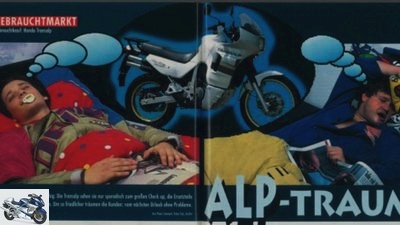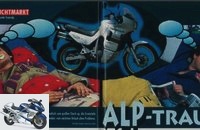Menus

consultation
Buy used Honda Transalp properly
Honda dealers sleep restlessly: they only see the Transalp sporadically for a major check-up, the spare parts are gathering dust on the shelves. Customers dream all the more peacefully: their next vacation without any problems.
The Honda XL 600 V with the model name caused a storm of enthusiasm Transalp by no means when it appeared on the German market in 1987. A water-cooled V2 engine in an enduro chassis that is also completely disguised and weighs over four hundred pounds? That was clearly too much for the traditional off-road guild, because then, many believed, they could buy a BMW right away.
Buy complete article

consultation
Buy used Honda Transalp properly
–
€ 2.00
Buy now
Honda still sold the Transalp almost 16,000 times. It is not suitable for difficult terrain, but as a travel machine that can also be used off-road, it can collect plus points: The civilian way of developing power, the comfortable seating position, the low consumption, solid workmanship and an exceptionally durable engine the owners hardly regret buying this motorcycle. Until 1992 the Transalp was also available with 27 HP and from 1993 with 34 HP, but the lion’s share is made up of the 50 HP version.
The facelift was kept within narrow limits over the years. From 1989 the transmission shaft and gears were modified so that the gears could be engaged even more easily. In addition, as part of the standardization of the V2 series, the engine received the valves, springs and rocker arms used in the VT 600 C and XRV 650 (Africa Twin). This increased the valve clearance from 0.1 each for inlet and outlet to 0.15 and 0.2 millimeters.
A new strut in less-wearing, because now encapsulated needle bearings should calm the rear end and a longer windshield reduce wind pressure during the journey. On top of that, Honda supplied a main stand on request, so that chain maintenance and possible tire repairs could be carried out during the trip without any adventurous contortions. And the side stand, which up until now had automatically retracted and which had unintentionally forced many Transalp to the ground, was replaced by a system with a contact switch that helped prevent costly damage to the fairing and handlebars. In 1991, the Transalp had a rear disc brake instead of a drum.
The most visually striking change was made to the Transalp in 1994 when the new fairing appeared slimmer and sportier, but was actually wider for better protection. Larger hand protectors were also available for the same reason. In addition, Honda responded to the criticism about the too weak front brake and gave it a modified double piston caliper and the adjustable lever armature of the Africa Twin for a better dosage. However, the new price rose enormously in the eight years of construction. In 1987 a copy cost 8,500 marks, but now 12,770 marks are due. At least for the 1996 season, the price remained constant.
What damage can actually be expected during a long transalp life? What is criticized in the very large number of readers’ letters? The exception here are the few transalpinists who like to go into the terrain with their scooters. Their percentage of Transalp owners is relatively low. Apart from the fact that Daniel Duwe, who crossed Africa, has proven that only unforeseen events, such as the civil war in Rwanda in 1994, can stop a Transalp with 140,000 kilometers from continuing.
A defect, however, runs through many reports. One of the two CDI boxes for the double ignition occasionally gives up the ghost. Placed directly under the seat bench, it comes under such pressure from the weight of the driver under the foam that the soldering points of the connector or the connector itself break. Since the black boxes are only available in a double pack for the proud price of 935 marks, either repairs are called for (see letter to the editor from Bodo Grins on page 122), or the units are mounted in such a way that the bench can no longer destroy them. On the chassis side, the front fork is too soft for some sporty riders. This can be remedied by spacers for a higher spring preload. Other transalpinists fill 50 to 100 cm³ more fork oil with a viscosity of SAE 10 and report a more sensitive response and more stable straight-line stability. Speaking of straight-line stability: Of course, the Transalp does not run as steadfastly on track at speeds of over 130 km / h as a super sports car. The wide, high handlebars and the comfortable, upright posture speak against this. But the handiness and good maneuverability even in easy terrain are the other side of the coin.
The range of accessories for the Transalp is huge and therefore huge here. Two readers, however, unanimously reported that they were wearing protective guards from Hepco & Becker almost fell on his nose – the mudguard caught on with heavy braking and the fork dipped into it.
Other points of criticism of the original Transalp: The tank holds almost 18 liters, but it can hardly be used because the last liters in the right half of the tank can hardly reach the fuel tap on the left side of the tank without a pump. But due to the two-cylinder’s low consumption of around five liters, it is enough for 300 kilometers in most cases. Also annoying on the tank: The unsunk tank cap is not the last word when it comes to attaching a backpack.
But these are small things in an otherwise well-engineered motorcycle that only needs large inspection intervals (with valve adjustments) every 24,000 kilometers and whose dignified finish leaves little to be desired. And last but not least: the engine is obviously almost indestructible.
And because that’s the way it is, Transalp is around 50,000 kilometers, almost irrespective of the year of construction, hardly less than 6,000 to 7,000 marks. If you’re lucky, you might get the first series with even more kilometers for 4,000 marks. But used buyers don’t have to worry about the mileage on the Transalp. Because Africa driver Daniel Duwe says his third Transalp “has just finished well with 73,000 kilometers”.
Related articles
-
Comparison test Honda XL 600 V Transalp against Kawasaki KLE 500
Comparison test Honda XL 600 V Transalp against Kawasaki KLE 500 Silent Stars Never made it big. Others collect prices, they are cheap. Now the …
-
On the move with the Honda XL 600 V Transalp
Volker Rost 26 pictures Volker Rost 1/26 Honda XL 600 V Transalp. Volker Rost 2/26 Honda had not had any luck with two-cylinder enduros until then. People…
-
Comparison test touring enduro bikes: Honda Transalp, Kawasaki Versys, Suzuki V-Strom 650
Jahn comparison test travel enduro: Honda Transalp, Kawasaki Versys, Suzuki V-Strom 650 Always on the wall, travel enduro does not necessarily mean BMW …
-
Art Top-Test Honda Transalp ABS The new old Two fewer spark plugs, two more valves, a new look and a 19-inch wheel – how much the new …
-
Honda Transalp 30th anniversary
Honda 30 years of the Honda Transalp The first two-wheeled SUV The Honda Transalp was undisputedly the first two-wheeled SUV. In 1987 the enduro came onto the market and …
-
Honda Transalp model overview and used advice
Honda Honda Transalp model overview and used advice All Transalp types The arms race for top performance has the Transalp in its 26 years …
-
Comparison test all-rounder: Cagiva Navigator, Honda XL 650 V Transalp, Yamaha TDM 850
Comparative test of all-rounders: Cagiva Navigator, Honda XL 650 V Transalp, Yamaha TDM 850 The sighted drivers sit on it, start up, drive off. No matter if short …
-
Triumph, Harley Davidson, Kawasaki and Honda Cruiser in the test
Jahn Chopper from Triumph, Harley Davidson, Kawasaki and Honda in the test Comparative test of mid-range cruisers up to 9,000 euros In the field of cruisers, the …
-
Artistic comparison of enduro concepts: BMW R 1150 GS, Honda XL 650 V Transalp, KTM LC 4 625 Supercompetition, MZ Baghira Enduro, Suzuki DR-Z 400 S Dream of …
-
Archive pictures Honda XRV 650 Africa Twin and the driving report from MOTORRAD 09-1988
Herzog 17 pictures Herzog 1/17 The bumpier the route, the clearer the Honda can set itself apart from competitors like the BMW R 80 GS ….